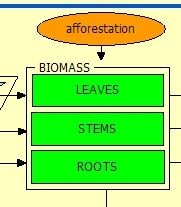
installation
the model.
Scenarios
and References
CASMOFOR
version 7.0
description
Description – Modelling – Accuracy, sources of error – Accounting functions
Description
Afforestation affects the carbon cycle of forests in several ways.The term afforesting itself means that new forest - or plantation, forest belt, other wooded land etc. - is established on land that was not covered with trees. This involves investing energy, and the work is usually done by machines that emit carbon-dioxide through burning fossil fuel. Thus, afforestation starts with carbon emission.
Moreover, afforestation starts with emission also because the planting of trees (or seeding) is usually preceded by soil preparation. Depending on the technology used, several of the organic soil layers can surface that contain undecomposed organic matter. The deomposition of this matter accelerates due to the activity of decomposing agents that live in the air of high oxigen content. Consequently, the land under site preparation, that does not contain any trees, starts to emit carbon-dioxide. This can also happen on lands that are regenerated after clearcut. During the soil preparation of regeration areas, roots, trunks and other underground organic matter is moved to the surface, where they quickly decompose. It can even happen in any type of soil preparation that years or even decades are necessary for the new stant to offset, with tree growth, the carbon that is emitted through disturbing the soil.
Finally, afforestation also affects the carbon cycle of forests, because it increases the amount of forests, thus, it increases the capacity of the forests to fix carbon.
Modelling
Modelling of the emission due to afforesting bare land is done by using simple constants (set, and changeable by the user, in user.xls): it is taken constant for unit land, and this constant is multiplied by the area that is afforested in a year.
Emission during soil preparation is also modelled by taking average value for unit of land. This constant is also multiplied, in any land, by the area affected by soil preparation.
The increase of forest area through afforestation is provided by the user as an input to the simulation. After afforestation, a 1-year-old forest is established, which fixes carbon as it is described at the section on growth.
Accuracy, sources of error
The amount of carbon that is emitted from machines operated in afforestations depends on species, spacing and site conditions, as well as other local conditions. Modelling all these conditions is outside the limits that would be necessary for CASMOFOR, since experience shows that overall emission from the machines is low, compared to the carbon fixing capacity of forests, even where the need for machines is greatest. Nevertheless, the structure of the model allows for changing current factors to better reflect emissions. (The factors can be given by species and yield class. Current data can be viewed in the knowledge base of the model.)
More important than this may be to model the the amount of carbon emitted during soil preparation. This, however, has not been done in CASMOFOR 2.0; some approximative value can be used if necessary that are based on expert judgement. However, the user is encouraged to use specific models that can be used to arrive at case-specific estimates. If these estimates are available, the amount of carbon fixed by the forest, which is estimated by CASMOFOR, can be reduced with the amount of emission estimated by the other model. In this case, the emission estimate by CASMOFOR, that can be withdrawn from the approppriate graph, must be added to the amount of fixed carbon.
External factor: SITE CONDITIONS
Description – Modelling – Accuracy, sources of error – Accounting functions
Description
Site is a term to denote abiotic factors that affect tree growth, and through this, directly or indirectly, all other ecosystem functions of the forest. It comprises climatic and soil factors both at short, as well as at long time scales.
Modelling
The effects of site are usually modelled indirectly by measuring mean tree height at a reference age. In Hungary, a similar approach has been used in forestry. At any given age, the distribution of mean tree height for a species is characterized by using six so called yield classes. These classes are thought to be in correlation with site characteristics, which are not measured. Once yield class of a stand has been identified, one can use yield tables to estimate future growth.
Accuracy, sources of error
There is only an empirical, statistical correlation between mean site conditions in the country and mean height growth. This general correlation may only apply to specific sites with high uncertainty. Moreover, the correlation may change over time, especially if the conditions of tree growth change quickly, as may be the case with climate change. No quantified estimate of uncertainty is usually available for site-growth relationships.
This webpage was last modified by Zoltan Somogyi 28 Sept 2023.



